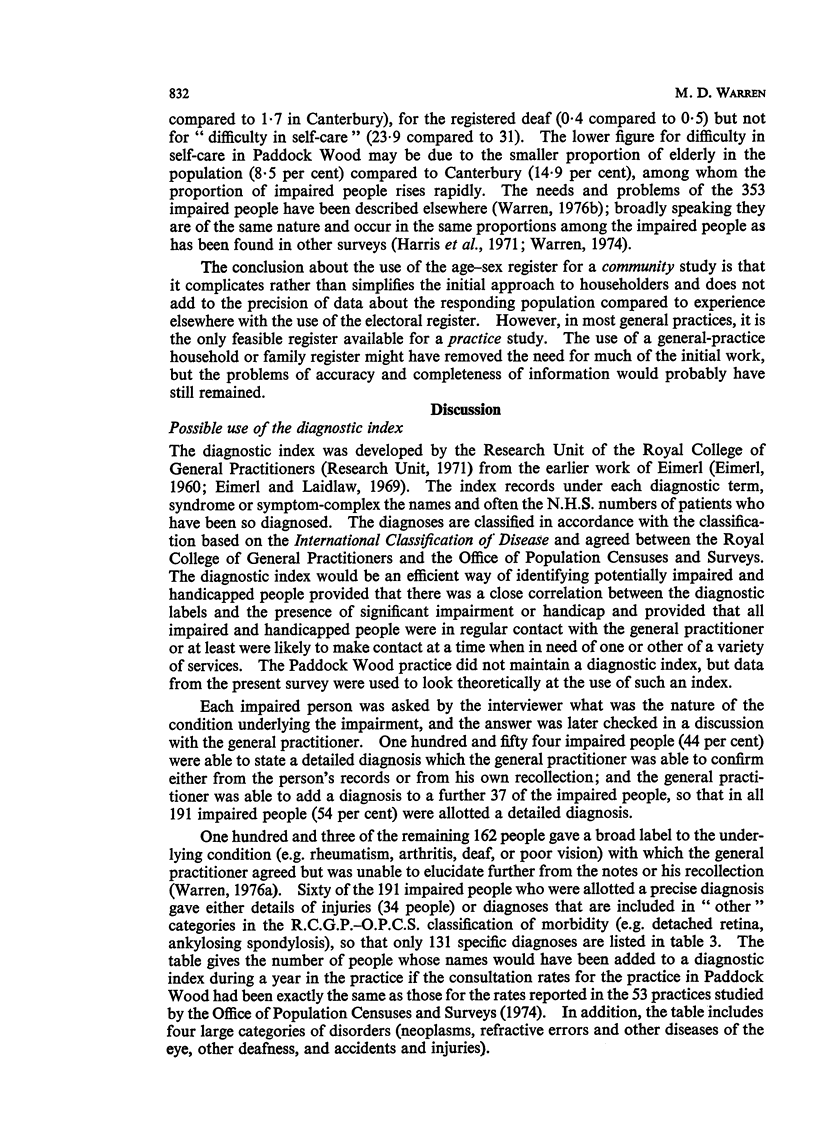Abstract
This study used the age-sex register of a group medical practice as the population base for a postal and follow-up interview enquiry to locate handicapped people and examined the possibility of the combined use of a practice diagnostic index and the patients' medical records for the same purpose. The age-sex register was found to contain deficiencies and inaccuracies despite the substantial efforts of members of the practice team to maintain it, for example, 13·5 per cent of the forms were returned as the addressee was unknown at the address.
The 81·5 per cent of householders who responded identified 353 impaired people who were subsequently interviewed about the nature of their impairment, the underlying condition, and the range of their activities. Depending upon the answers to these questions, a proportion of these people were classified as handicapped and were asked further questions. The number of impaired people and their distribution in sex and age-groups were broadly similar to the findings from other surveys. The diagnoses of the underlying conditions given by the impaired people were discussed with the general practitioners and confirmed or otherwise by the use of the patients' notes or the recollections of the general practitioners.
It was concluded that while the use of a diagnostic index would be helpful for some conditions, there would remain a substantial number of people with a disease that is potentially disabling who would have to be approached for further screening and also a substantial number of people who are handicapped, but who would be missed.
Full text
PDF








Selected References
These references are in PubMed. This may not be the complete list of references from this article.
- Agerholm M. Handicaps and the handicapped: a nomenclature and classification of intrinsic handicaps. R Soc Health J. 1975 Feb;95(1):3–8. doi: 10.1177/146642407509500104. [DOI] [PubMed] [Google Scholar]
- Bennett A. E., Garrad J., Halil T. Chronic disease and disability in the community: a prevalence study. Br Med J. 1970 Sep 26;3(5725):762–764. doi: 10.1136/bmj.3.5725.762. [DOI] [PMC free article] [PubMed] [Google Scholar]
- Dawes K. S. Survey of general practice records. Br Med J. 1972 Jul 22;3(5820):219–223. doi: 10.1136/bmj.3.5820.219. [DOI] [PMC free article] [PubMed] [Google Scholar]
- Eimerl T. S. Organized Curiosity: A Practical Approach to the Problem of Keeping Records for Research Purposes in General Practice. J Coll Gen Pract. 1960 May;3(2):246–252. [PMC free article] [PubMed] [Google Scholar]
- Hannay D. R. Accuracy of health-centre records. Lancet. 1972 Aug 19;2(7773):371–373. doi: 10.1016/s0140-6736(72)91748-5. [DOI] [PubMed] [Google Scholar]
- Jefferys M., Millard J. B., Hyman M., Warren M. D. A set of tests for measuring motor impairment in prevalence studies. J Chronic Dis. 1969 Nov;22(5):303–319. doi: 10.1016/0021-9681(69)90073-3. [DOI] [PubMed] [Google Scholar]


